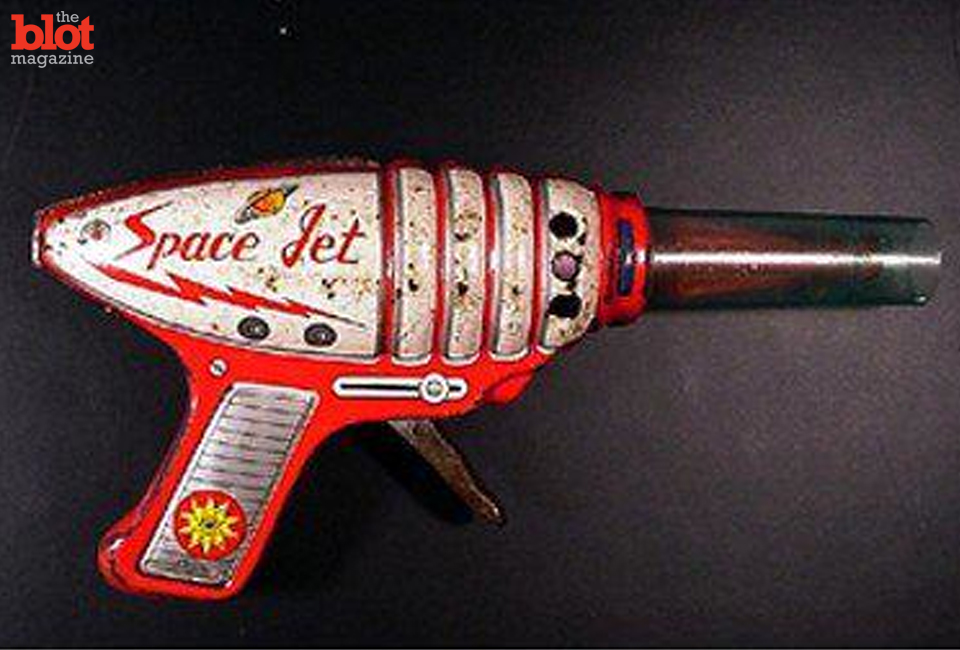
It’s the gift-getting season, and that means some goody two-shoes pretend journalist will come on TV shortly to tell us all about the dangerous toys we need to avoid to make this holiday $ea$on a safe and lucrative one.
As the father of three and grandfather of another, I appreciate that keeping kids safe is a good idea, but America has become obsessed with children’s safety in the last generation. We’ve done everything but bubble-wrap the little dears and build houses out of Nerf to keep them from getting the slightest boo-boo. We’re depriving them of the thrill of almost losing a limb. Hell, I played with some of history’s most dangerous toys, and apart from subversive thoughts and giggling during horror movies, I turned out only a standard deviation or two away from normal.
One of the toys that makes the list were Creepy Crawlers.
 I loved this stuff. Also sold as “Thingmaker,” this had cast metal dies into which you poured “Plasti-Goop” and then heated it over an open-face electric hot plate to about 400 degrees. The goop turned into rubbery little toys. My favorite part was putting the hot mold into a “cooling bath” — a plastic tray that held enough water to make a sizzling sound. What could go wrong? Hot metal and plastic in the hands of an 8-year-old. Fun.
I loved this stuff. Also sold as “Thingmaker,” this had cast metal dies into which you poured “Plasti-Goop” and then heated it over an open-face electric hot plate to about 400 degrees. The goop turned into rubbery little toys. My favorite part was putting the hot mold into a “cooling bath” — a plastic tray that held enough water to make a sizzling sound. What could go wrong? Hot metal and plastic in the hands of an 8-year-old. Fun.
Then, there were lawn darts. My pal Kyle Long had these, the brand name was “Jarts.”
 The game was played like horseshoes. You’d throw a 12-inch dart with a pointed metal tip about 35 feet toward a ring target. Thanks to three deaths over the years, the darts now just have a weighted end. Who would ever have imagined that throwing a pointed dart that resembled a crossbow bolt would penetrate a kid’s skull? Actually, Kyle’s dad did – we were not allowed to play with them if Dr. Long (a dentist) wasn’t there to watch us.
The game was played like horseshoes. You’d throw a 12-inch dart with a pointed metal tip about 35 feet toward a ring target. Thanks to three deaths over the years, the darts now just have a weighted end. Who would ever have imagined that throwing a pointed dart that resembled a crossbow bolt would penetrate a kid’s skull? Actually, Kyle’s dad did – we were not allowed to play with them if Dr. Long (a dentist) wasn’t there to watch us.
Another great toy was the spark gun, which you could buy at any tourist trap or souvenir stand in the U.S. during the 1960s and 1970s.
These were cool because they were guns (which is always cool) that emitted sparks when you pulled the trigger. The sparks were created by good old fashion flint and steel or something similar (I never was the kind of kid who broke his toys to see how they worked). In other words, you were playing with a fire hazard. The sparks themselves hurt just a little bit, but the butt-whipping you’d get when you managed to burn your house down was bad.
Among the more stupid toys were Clackers.
 These were all the rage when I was in sixth grade. The toy consisted of two hard acrylic plastic balls tied together with a string. The idea was to move your hand in such a way that the balls would clack off one another, each moving in a semi-circle until it struck the other, and then moving in another semi-circle to strike the other ball again moving in the opposite direction. Bruised forearms were inevitable until you got really good at it. And the balls sometimes shattered. And in Argentina, the gauchos call these weapons bolas.
These were all the rage when I was in sixth grade. The toy consisted of two hard acrylic plastic balls tied together with a string. The idea was to move your hand in such a way that the balls would clack off one another, each moving in a semi-circle until it struck the other, and then moving in another semi-circle to strike the other ball again moving in the opposite direction. Bruised forearms were inevitable until you got really good at it. And the balls sometimes shattered. And in Argentina, the gauchos call these weapons bolas.
The first half of the 1960s marked the centennial of many important events during the American Civil War (or as I think of it, the War of Southern Treason). As a result, you could sell just about anything that tied into the conflict. I can’t remember which of the O’Donnell brothers had the Remco Johnny Reb Cannon, but it was one of the older ones (maybe the one who did time for car theft? I don’t know).
Anyway, the three-foot-long cannon used a spring mechanism to launch a rather heavy ball about 35 feet. Naturally, you weren’t supposed to shoot it at anyone, but, well …
The next two are science “toys” that I didn’t really play with, but I had something very similar. The first is the Gilbert Chemistry Outfit For Boys.
 Now, I had a chemistry set, but it wasn’t from the good people at Gilbert. Unlike theirs, mine was safe enough to use indoors. And unlike theirs, I couldn’t take two relatively safe compounds and make nitric acid (mine had the potassium nitrate but not the sodium hydrogen sulfate). Still, my test tubes were just as breakable as theirs, so I suppose I might have cut myself.
Now, I had a chemistry set, but it wasn’t from the good people at Gilbert. Unlike theirs, mine was safe enough to use indoors. And unlike theirs, I couldn’t take two relatively safe compounds and make nitric acid (mine had the potassium nitrate but not the sodium hydrogen sulfate). Still, my test tubes were just as breakable as theirs, so I suppose I might have cut myself.
Also from the folks at Gilbert was the Gilbert U 238 Atomic Energy Laboratory that was on sale in 1951/1952.
 Yep, for just $50 (a hefty amount in those days), you got a Geiger counter, a cloud chamber for detecting alpha particles, a spinthariscope that showed radioactive disintegration on a fluorescent screen and an electroscope that could measure the radioactivity of different substances. Oh, yeah, you also got a small sample of Uranium-238. U-238 is the most commonly occurring isotope of uranium in the world, nicely radioactive, but not useful for making bombs — but you can turn it into Plutonium-239 which is, but for that you need a much bigger lab.
Yep, for just $50 (a hefty amount in those days), you got a Geiger counter, a cloud chamber for detecting alpha particles, a spinthariscope that showed radioactive disintegration on a fluorescent screen and an electroscope that could measure the radioactivity of different substances. Oh, yeah, you also got a small sample of Uranium-238. U-238 is the most commonly occurring isotope of uranium in the world, nicely radioactive, but not useful for making bombs — but you can turn it into Plutonium-239 which is, but for that you need a much bigger lab.
I didn’t have an atomic energy lab, but I did get a geology lab set when I was 9. Not only did it include uranium ore (just a short acid leaching away from being yellowcake), but it also had asbestos fibers. One of the experiments for that was to light a match and watch the asbestos not burn. And then, you blew the match out — after taking a deep breath of air only inches away from the asbestos fibers.
With toys like these, it’s amazing anyone born in the 1950s or 1960s even made it to adulthood.
Jeff Myhre is a contributing journalist for TheBlot Magazine.






